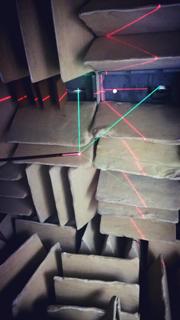Apr 29 2015
Scientists at the National Physical Laboratory (NPL) - the UK's National Measurement Institute - have developed an optical method for remotely measuring sound pressure inside a fully anechoic chamber which is the first to provide direct traceability to the SI base units.
 The new technique uses laser beams that intersect at a point to produce an interference fringe volume. Credit: NPL
The new technique uses laser beams that intersect at a point to produce an interference fringe volume. Credit: NPL
Accurate measurements of airborne sound are needed for a range of regulatory, health and safety, and commercial applications, from monitoring environmental noise to testing the performance of acoustic devices. To ensure reliable measurements of sound pressure, microphones must be regularly calibrated by measuring their sensitivity over a certain frequency range.
Currently, the most accurate method for calibrating microphones is based on the principle of reciprocity - a theory first conceived by Lord Rayleigh nearly 150 years ago. However, this method can only be used to calibrate a limited number of microphones of specific types and dimensions, and cannot be applied to new types of device such as microelectromechanical systems (MEMS). The unit of sound pressure, the pascal, is also currently determined indirectly through assumptions on the propagation characteristics of sound and the dimensions of the device being tested.
Researchers at NPL have developed a new optical method for directly measuring sound pressure. The method can be used to determine the sensitivity of any acoustic device with direct traceability to length standards, and without assumptions regarding the geometry and sound field characteristics.
The method, published in the journal Applied Physics Letters, is based on an optical technique known as photon correlation spectroscopy. Two laser beams are crossed to form an interference fringe volume - the pattern caused by the interaction of the two waves. Sound waves are emitted by a source within the test chamber, causing airborne particles to oscillate. As the oscillating particles cross the interference fringes, they scatter photons, which can be detected by a single photon counter. From this, the particle velocities can be measured in a direct and absolute manner and are used to determine the pressure. By repeating the procedure at a range of different emitted frequencies, acoustic devices can be calibrated directly against the acoustic unit of sound pressure.
The optical method can form the basis of a future primary standard for sound pressure measurement which is directly traceable to the SI base units. An extensive theoretical and experimental study of the sources of uncertainty would be needed prior to the introduction of such a standard, and this work is currently underway.